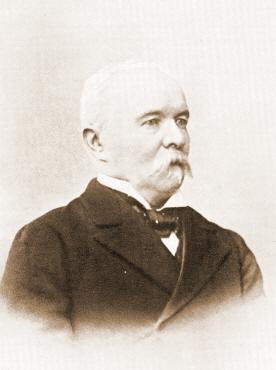
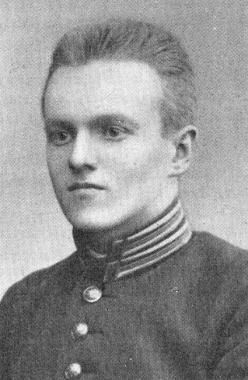
Edward Winter
The great St Petersburg tournaments of 1895-96, 1909 and 1914 would hardly have existed without two of chess history’s outstanding organizers and patrons, Peter Alexandrovich Saburov and his son, Peter Petrovich Saburov, but how many people today would even recognize their names?


Peter Alexandrovich Saburov and Peter Petrovich Saburov
The present item expands upon our research into the Saburovs published in Chess Notes in 1983. As regards P.A.S. (1835-1918), C.N. 492 warmly recommended The Saburov Memoirs or Bismarck & Russia by J.Y. Simpson (Cambridge, 1929), a work which acknowledged assistance from P.P.S. but was mainly a translation of Ma Mission à Berlin 1879-1884 by P.A.S. himself.
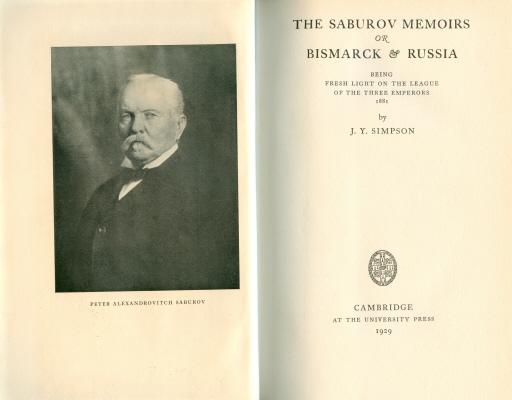
The book traced his remarkable career. He was born on 22 March/3 April 1835 on the estate of Veryaevo in the district of Elatma in the Government of Taboff. His brother Andrew held for several years the portfolio of the Minister of Public Instruction. P.A.S. went to the Imperial Alexander Lyceum, St Petersburg until 1854, gaining a first gold medal. After employment in the Chancellery from 1857 to 1859, he worked in Munich, and then in England, where he stayed for 11 years, meeting the leading British statesmen. In 1870 he went to Carlsruhe, and subsequently moved on to Athens, where he stayed until 1879. In the summer of 1879 he was to be found in Constantinople, in which city he was appointed Russian Ambassador, although he never entered upon the duties. Then he did a four-year stint in Berlin (1880-1884), after which he left the diplomatic service. During the last decade of the century he became well known as a financial and economic expert. He listed his pastimes as pomiculture, architecture, the piano and chess. His eldest son died at the hands of peasants. After the revolution, in March 1917, P.A.S., as a senator, was appointed to a commission associated with the Senate, but was dismissed upon the accession of the Bolsheviks. Following a short illness he died on 28 March/10 April 1918 in Petrograd.
It would be impossible to summarize here his diplomatic dealings with Bismarck and other prominent figures of the time, but J.Y. Simpson’s book provides fascinatingly detailed reading on the subject.
Apart from a few consultation games (e.g. with Chigorin), little of P.A.S.’s chess seems to have been recorded, but one specimen may be given below:
P.A. Saburov – E. Znosko-Borovsky
St Petersburg, 1900
Ruy López
1 e4 e5 2 Nf3 Nc6 3 Bb5 a6 4 Ba4 d6 5 c3 Bd7 6 d4 Nf6 7 d5 Nb8 8 Bc2 Be7 9 Be3 O-O 10 Nbd2 Ne8 11 h3 f5 12 exf5 Bxf5 13 Bxf5 Rxf5 14 Qc2 Rf8 15 Ne4 h6 16 h4 Qd7 17 Ng3 Bf6 18 Ng5 hxg5 19 hxg5 Kf7 20 Nf5 Bd8 21 g6+ Kg8 22 g4 Nf6 23 f3 Nxd5 24 Qh2 Resigns.
Source: Deutsche Schachzeitung, October 1904, pages 305-306, which gave the game with Chigorin’s notes from Novoye Vremya. (In 1861 ‘Mr Saburov of the Russian embassy’ defeated Paulsen in the latter’s ten-board blindfold display in London. For a report and the game-score, see pages 337-348 of the Chess Player’s Chronicle, 1861 and C.N. 2868.)
Nor was Saburov junior a prominent player. Although it was no disgrace to be defeated, at Ostend, 1906, by players of the calibre of Burn, Janowsky, Leonhardt, Bernstein, Blackburne and Důras, it was Saburov’s sombre distinction to be the only contestant of the 36 to finish without scoring even half a point. (His result was +0 =0 –9.) Finding impressive specimens of his play is not easy, but here is the conclusion of a game played in Geneva against an anonymous opponent:
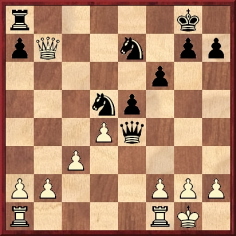
P.P. Saburov (Black) drew as follows: 1…Re8 2 c4 Nc3 3 d5 Ne2+ 4 Kh1 Qh4 5 d6 Nf5 6 d7 Nfg3+ 7 fxg3 Nxg3+ 8 Kg1 Ne2+.
Source: La Stratégie, 17 March 1905, page 92.
For biographical information on the younger Saburov a helpful source is pages 246-247 of the November 1911 American Chess Bulletin:
‘Peter Petrovich Saburov, President of the far-famed St Petersburg Chess Club and Vice-President for Russia of the New York International Chess Congress [i.e. the major tournament planned for January 1912 but subsequently abandoned], was born in St Petersburg on 2 (14) January 1880. At the age of 20 he had completed his course at the Imperial Alexander Lyceum. Three years, 1901-04, were spent in the Ministry of Foreign Affairs, and the next two in the office of the chancellor of state. The title of Gentleman of the Chamber at the court of H.I.M., the Emperor of Russia, was bestowed upon him in 1905. A year later, he retired from the state service with the title of Collegiate Assessor. At this writing, Mr Saburov is studying musical composition at the St Petersburg Conservatory, which he entered in 1909.
The father of Mr Saburov, His Excellency P.A. Saburov, now an honorary President of the St Petersburg Chess Club, himself a strong amateur, has in his day done much for the chess life at the capital, having been instrumental in the arrangement of the Lasker-Steinitz-Pillsbury-Chigorin tournament of 1895-96. His wife, a niece of the late Woldemar Graf Vitzthum von Eckstädt, well known as a German expert, taught the son to play chess when he was 16.
The subject of this sketch has attained the strength of a player of the second class, his chief success having been first prize in a tombola tournament at St Petersburg in June, 1903. But it is not as a player so much as an organizer that he has made his mark. During the season of 1902-03 there were fortnightly chess matinees at his home, which were frequented by such experts as Chigorin, Schiffers, Lewin and E. Znosko-Borovsky. About that time, Sergius Znosko-Borovsky, older brother of the master and whose death on 10 August has just been reported, formed a small private society of chess amateurs. When, in 1904, this coterie was transformed into the St Petersburg Chess Club, P.P. Saburov was elected Vice-President, holding that office until 1908, when he was elected President. Next year, he retired from the committee, but resumed his activities in 1910 as chief manager of the tournaments. This year, he was again elected to the Presidency.
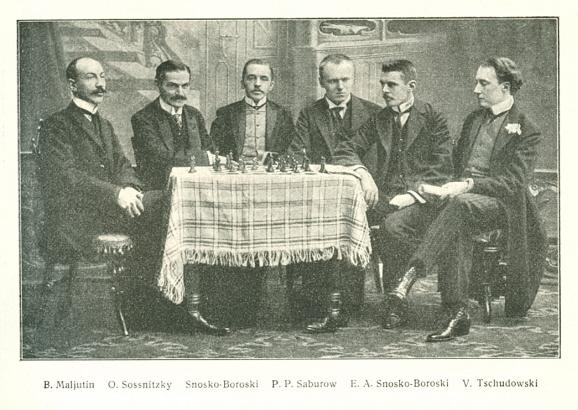
St Petersburg, 1909
The most important events for which the chess world is indebted to this energetic executive are the international tournament of 1909, the last in which Dr Lasker took part; the concurrent Russian amateur tourney, the fourth Russian national tournament of 1905-06, a quandrangular tourney between Chigorin, Alapin, Znosko-Borovsky and Evtifiev in 1906, and the Rice Gambit tournament of 1905. Mr Saburov was a member of the committees of the second and third tournaments held at Ostend in 1906 and 1907, and of the fifth national held at Łódź in 1907. Aside from all this, ambitious Russian players did not lack for encouragement on the part of this keen enthusiast. Little wonder, therefore, that of the 26 contestants at Carlsbad no less than nine were from the Dominions of the Tsar.’
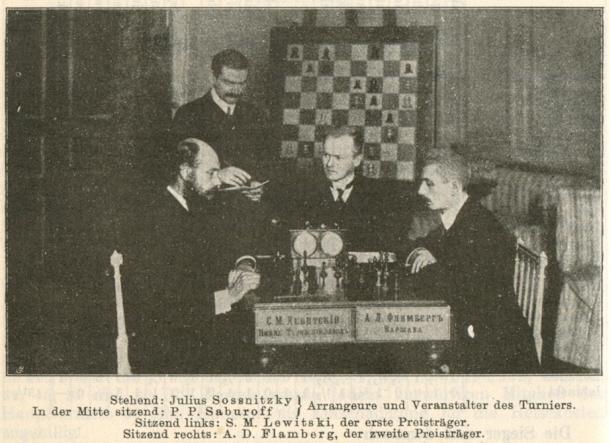
Source: Wiener Schachzeitung, November-December 1911, page 340
In addition to his subsequent involvement in organizing St Petersburg, 1914, P.P.S. was a prime mover in attempts during that tournament to create an international chess federation. (See pages 129-130 of Chess Explorations.)
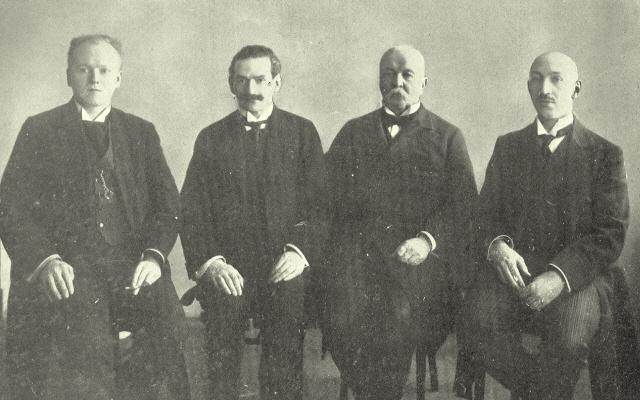
The organizers of St Petersburg, 1914. From left to right: P.P. Saburov, Y.O. Sosnitsky, P.A. Saburov and B.E. Maliutin
In 1918, the year of his father’s death, P.P.S. had not yet left Russia. Writing about the possible whereabouts of Alekhine, Burn noted in The Field of 23 October 1920:
‘Mr P.P. Saburov, the President of the Russian Chess Association, informs us that in 1918, when he, Saburov, was still in Russia, a small local masters’ tournament was played in the spring of that year at Alekhine’s residence in Moscow …’
Having settled in Switzerland, P.P.S. all but vanished from chess literature. One of his rare re-appearances was on page 371 of the October 1923 BCM, which referred to a letter he had written to the magazine correcting a reference to Schiffers, Schlechter and Zukertort having been Jews. Under the heading ‘A Letter from Switzerland’, page 189 of the December 1930 American Chess Bulletin published a brief text from ‘Peter P. Saburov, Former President of the Committee of the Pan-Russian Chess Society and former President of the Committee of the St Petersburg Chess Assembly’ in which he rather lamely listed the leading players he wished to see invited to a proposed double-round tournament in the USA.
Little has yet been discovered about his accomplishments as a composer of music, but below is a paragraph from page 305 of the July 1925 BCM:
‘Chess and Music. – P.P. Saburov, who was once president of the Pan-Russian Chess Federation, and also of the Petrograd Chess Club, has composed a Love Symphony for big orchestra, which was played for the first time on 6 May in the “Concert Classique” at Monte Carlo and proved a great success.
The Scherzo (third part) of the symphony is called “Simultaneous Games of Chess”.’
P.P.S died in Switzerland in 1932 – in March of that year according to the inaccurate obituary on pages 139-140 of the May 1932 Deutsche Schachzeitung. In 1983 we examined the local newspapers (e.g. the Tribune de Genève of 24 February, 25 February and 28-29 February 1932) and learned that on 24 February ‘Pierre [de] Sabouroff’ was discovered lying on the floor of his home (6 rue du Collège, Carouge) after suffering a cerebral haemorrhage. He died at the Hôpital cantonal in Geneva on 26 February 1932 (and not, as we incorrectly wrote in C.N. 448, in Carouge). The newspapers described him as a musician (‘cet artiste, dont les oeuvres et les connaissances d’historien de la musique sont si appréciées à Genève et à l’étranger’) who gave private lessons on the history of music. No mention of chess has been found in any of the newspaper reports of his demise.
(2672)
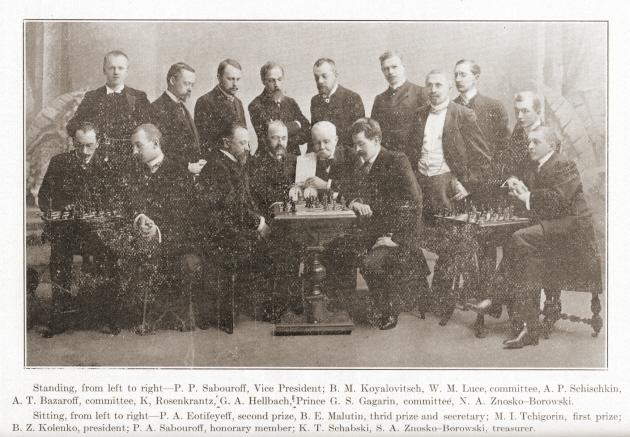
Source: American Chess Bulletin, May 1906, page 88. The occasion was the St Petersburg Chess Club Rice Gambit Tourney.
(7170)
The text of C.N. 2868, which gave an additional specimen:
The following game occurred in a ten-game blindfold exhibition by Paulsen at the Cigar Divan in the Strand, London:
Louis Paulsen - Peter Alexandrovich Saburov
London, 1861
Falkbeer Counter-Gambit1 e4 e5 2 f4 d5 3 exd5 e4 4 c4 Bc5 5 Ne2 Nf6 6 b4 Be7 7 Nbc3 O-O 8 Qb3 c6 9 Ng3 Re8 10 Be2 cxd5 11 cxd5 a5 12 b5 Bg4 13 Bb2 Bxe2 14 Ngxe2 Nbd7 15 Na4 Nc5 16 Nxc5 Bxc5 17 Qg3 e3 18 d3 Bb4+ 19 Kd1 Qxd5 20 Nc1 Rac8 21 Bxf6
21…Rxc1+ 22 Kxc1 Rc8+ 23 Kb2 Ba3+ 24 Kxa3 Qc5+ 25 White resigns.
Source: the Chess Player’s Chronicle, 1861, page 340.
The Chronicle reported (pages 337-338) that the display had lasted from 14.00 to 02.20 the following morning:
‘As soon as the ten players had taken their places, Mr Paulsen ascended a table at the side of the room, and seated himself upon a chair with his back towards the chess boards. He is a young man of fair complexion, 22 years of age, though looking older, tall and slimly built, with a handsome forehead. [Paulsen was aged 28.] … At ten, M. Saburov, his Russian adversary, whose skill he had rather underrated, achieved a victory.’
Paulsen’s final score was +2 –3 =5.
The website e-newspaperarchives.ch provides an opportunity to read more about the music activities of Peter Saburov (Pierre de Sabouroff). For example:
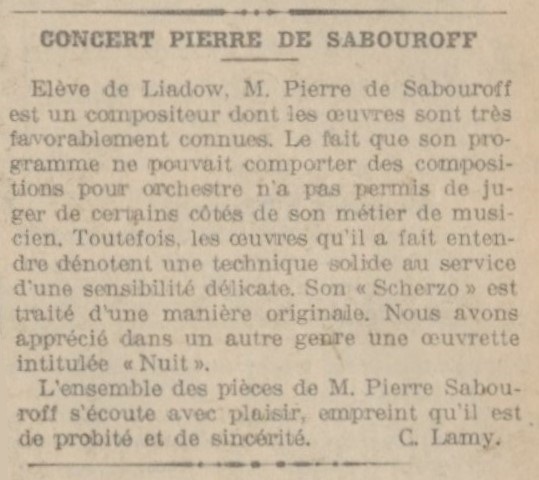
Source: Courrier de Genève, 19 December 1925, page 5.
Such material complements the biographical information about him given, from the Tribune de Genève, in C.N.s 448 and 2672.
(12198)
To the Chess Notes main page.
To the Archives for other feature articles.
Copyright: Edward Winter. All rights reserved.